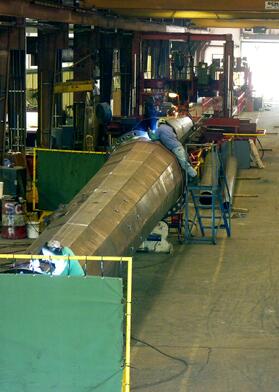Being a fabricator, we see a variety of fabrication drawings. Not only do we fabricate from drawings generated by our own engineering and detailing groups, but we also fabricate from drawings generated by others. These customer supplied drawings can vary greatly from 20 year-old hand drawn steel drawings to highly detailed drawings with 3D images of the connections. Ultimately, the fabrication drawings are the link between the engineer who is designing the structures and the fabricator fabricating the structures.
Having clear fabrication drawings and state of th art manufacturing equipment increases the likelihood that the steel being fabricated turns out exactly how the engineer intended. The drawings do not have to be fancy or highly sophisticated in order the get the message across to the fabricator; however, they should contain the needed information and make sure it’s shown correctly.
Examples of this include:
- Fabrication Notes
- Clear Section Views
- Proper Weld Symbols, etc.

The use of proper weld symbols is a critical component to the fabrication drawings. If the weld is shown incorrectly or left up to the interpretation of the welder, then it can make the difference of whether the connection will hold up to the loadings. One main problem is incomplete or vague weld symbols that could be interpreted different ways.
Some of the different welds include:
- Fillet Weld
- Single Bevel Weld
- Single V-GROOVE Weld
- J-Groove Weld
- U-Groove Weld
- Square Groove Weld
Welding symbols provide a system for placing welding information on drawings and work sites for the purpose of relaying information to fitters, welders, fabricators, inspectors, etc. These symbols quickly indicate the type of weld joint needed to satisfy the requirements for the intended service. AWS A2.4 Standard Symbols for Welding, Brazing, and Nondestructive Examination is the correct standard. It's a great method for communication between the design engineer and the fabricator, but if the fabricator fails to gain a thorough understanding of what the engineer is requiring, then that could result in welds being placed in the wrong location, sized incorrectly, wrong welding processes, etc.
The engineer on record who designed the structures, also signs-off on the fabrication drawings, and is ultimately responsible for correct weld symbols. As a fabricator, it’s a good practice to glance over the drawings before they hit the shop floor in order to be proactive and head off any issues. They should also have trained welders that flag any weld symbols that are unclear so that they can ask for clarification. However, if it gets to this point it can start affecting the shop production because the welder could be on standby waiting on a response. For a fabricator, a welder standing around waiting is not a good thing.
Referencing AWS A2.4 will help guide and protect all parties so that their projects are a success, as well as allow everyone to be on the same page talking the same “language”.
